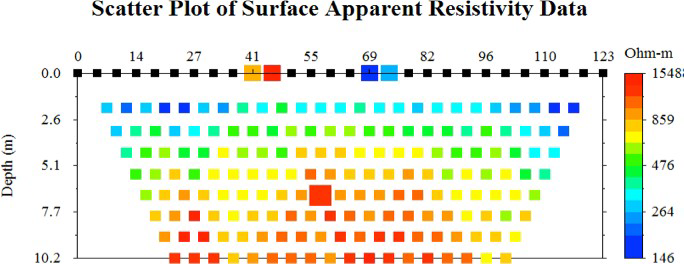Electrical Resistivity Tomography (ERT)
Overview of Resistivity:
DC Resistivity is a surface geophysical method that provides information about subsurface electrical resistivity distribution through the injection of electric current into the earth and the measurement of the corresponding voltage. Typically, current is sent into the subsurface via two dedicated current electrodes and the resulting potential difference is measured by two dedicated potential electrodes. The resistance of subsurface earth materials can then be calculated and depending on the arrangement of electrodes, apparent resistivity values are calculated from the estimated resistances.

Resistivity of soil and rock is a complicated function of moisture (water) content, a dominant factor, porosity, pore fluid chemistry (fresh water vs. saltwater), temperature of pore water (resistivity decreases with increasing temperature), resistivity of minerals. Apparent resistivity is a weighted average of the resistivities under the four electrodes. This method provides in-situ information about lithologic composition, metal content, pore fluid chemistry, porosity, and permeability so it is particularly well suited to finding zones that have saturated materials.

The figure displays an example of the raw, “apparent resistivity”. Data produced by this method in a “Pseudosection” display.
Some applications of DC Resistivity include: cavity and sinkhole detection, geotechnical site characterization, groundwater exploration, lithologic mapping, mineral exploration, archaeological site investigation, detection of free products of contaminant plumes, time lapse monitoring of remediation process such as steam injection, air sparging, injection of various oxidants such as hydrogen peroxide (H2O2) and potassium permanganate (KMnO4); time lapse monitoring of subsurface processes such as groundwater recharge, infiltration, saltwater intrusion, tunneling, and dam leakage.
IP
Like the DC Resistivity method, the IP method is an electrical geophysical method that measures some earth response to injected current. However, unlike the electrical resistivity method which gives information about subsurface resistivity distribution, IP gives information about the chargeability of subsurface earth materials. Chargeability is a physical property that describes the earth’s capacity in storing electrical charge. The IP effect is produced when there is fluid present in the pores of the subsurface material and there’s an electron transfer between the ions of the fluid and alteration products e.g., clays, graphite etc. Chargeability can be measured in both the time-domain with time-domain IP and the frequency domain with frequency-domain IP. The IP method is typically used in mineral exploration but also in geothermal studies and some for some cases in hydrocarbon exploration as well.
SP
The Self-Potential method, unlike ER and IP, does not involve injecting current into the ground. We call it a passive electrical geophysical method. In the SP method, we measure natural electric voltage differences in the earth, which is given rise to by any number of events including the flow of water in the subsurface through a porous medium, geochemical disturbances etc. Applications of SP include finding zones of flowing groundwater, evaluating the integrity of dams and reservoir leakage studies among others. A voltmeter and nonpolarizing electrodes are required to measure SP.

